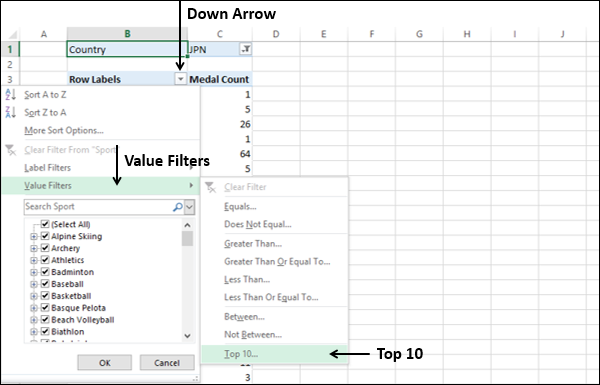
- DAX - Home
- DAX - Overview
- DAX - Calculated Columns
- DAX - Calculated Fields / Measures
- DAX - Editing a Calculated Field
- DAX - Deleting a Calculated Field
- DAX - Syntax
- DAX - Operators
- DAX - Standard Parameters
- DAX - Functions
- DAX - Understanding DAX Functions
- DAX - Evaluation Context
- DAX - Formulas
- Updating Results of DAX Formulas
- Updating Data in the Data Model
- DAX - Recalculating DAX Formulas
- Troubleshooting DAX Formula Recalculation
- DAX - Formula Errors
- DAX - Time Intelligence
- DAX - Filter Functions
- DAX - Scenarios
- Performing Complex Calculations
- DAX - Working with Text and Dates
- Conditional Values & Testing for Errors
- DAX - Using Time Intelligence
- DAX - Ranking & Comparing Values
Excel DAX - Ranking and Comparing Values
If you want to show only the top n number of items in a column or PivotTable, you have the following two options −
You can select n number of top values in the PivotTable.
You can create a DAX formula that dynamically ranks values and then uses the ranking values in a Slicer.
Applying a Filter to Show only the Top Few Items
To select n number of top values for display in the PivotTable, do the following −
- Click the down arrow in the row labels heading in the PivotTable.
- Click the Value Filters in the dropdown list and then click Top 10.

Top 10 Filter (<column name>) dialog box appears.
- Under Show, select the following in the boxes from left to right.
- Top
- 18 (The number of top values that you want to display. The default is 10.)
- Items.
- In the by box, select Medal Count.

Click OK. The top 18 values will be displayed in the PivotTable.
Advantages and Disadvantages of Applying Filter
Advantages
- It is simple and easy to use.
- Suitable for tables with large number of rows.
Disadvantages
The filter is solely for display purposes.
If the data underlying the PivotTable changes, you must manually refresh the PivotTable to see the changes.
Creating a DAX Formula That Dynamically Ranks Values
You can create a calculated column using a DAX formula that contains the ranked values. You can then use a slicer on the resulting calculated column to select the values to be displayed.
You can obtain a rank value for a given value in a row by counting the number of rows in the same table having a value larger than the one that is being compared. This method returns the following −
A zero value for the highest value in the table.
Equal values will have the same rank value. If n number of values are equal, the next value after the equal values will have a nonconsecutive rank value adding up the number n.
For example, if you have a table Sales with sales data, you can create a calculated column with the ranks of the Sales Amount values as follows −
= COUNTROWS (FILTER (Sales, EARLIER (Sales [Sales Amount]) < Sales [Sales Amount]) ) + 1
Next, you can insert a Slicer on the new calculated column and selectively display the values by ranks.
Advantages and Disadvantages of Dynamic Ranks
Advantages
The ranking is done in the table and not on a PivotTable. Hence, can be used in any number of PivotTables.
DAX formulas are calculated dynamically. Hence, you can always be sure that the ranking is correct even if the underlying data has changed.
Since the DAX formula is used in a calculated column, you can use the ranking in a Slicer.
Suitable for tables with large number of rows.
Disadvantages
Since the DAX calculations are computationally expensive, this method might not be suitable for tables with large number of rows.